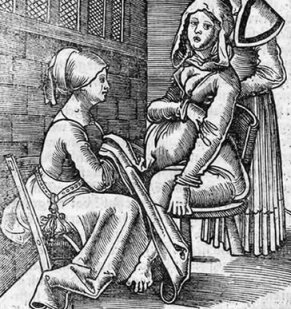Biblical times:
- The history of the labor and delivery unit begins in the Old Testament: Exodus, Chapter 1. The Bible describes how the children of Israel (Hebrews) were enslaved in Egypt and they multiplied greatly.
- Midwives delivered babies in these times and were regulated under Moses and educated young women about having children.
Middle Ages (500AD- 1600AD):
- Midwives were seen as incompetent and ignorant for the folk medicine they practiced.
- Male surgeons began to assert that their modern techniques were better for mothers and infants than midwifery. These modern men pushed for a legal monopoly on obstetrical care and midwifery became outlawed.
- Midwives were eventually deemed competent to deliver babies around 1600 AD and continued to perform in home deliveries up until the 19th century.
Progressive Era (1890-1920):
- A combination of societal forces pushed birth into the hospital. Due to industrialization, urbanization began and cities became crowded and unsanitary. These conditions led to an increase in the number of hospitals.
- Infection was the most common cause of death of mothers, accounting for 40% to 55% of maternal mortality into the late 1930s. Toxemia caused approximately 20% of deaths, and hemorrhage another 20%.
- Proponents of medical care for birth believed that to ensure mothers’ safety and comfort, birth should be attended by physicians, preferably in hospitals. Most nurses were women, so they provided the female connection useful to convince mothers to substitute medical care for the midwifery care they had used since colonial days.
1930-1980:
- Big changes in child birth begin to show.
- The American Board of Obstetricians and Gynecology was established. Obstetricians sought to achieve dominance over midwives. However, a scholar who conducted an intensive study concluded that the 41 percent increase in infant mortality due to birth injuries between 1915 and 1929 was due to obstetrical interference in birth.
- From 1930 up until about 1980 many experiments with labor and delivery were being tested. Obstetricians were attempting to find easier, faster ways for women to give birth. One technique was Twilight sleep. It caused women to lose control and the maternal mortality rate to rise to 47 deaths per 1,000.
- Lyndon Johnson signed Medicaid and Medicare into effect, the International Childbirth Education Association was created, and the Birth Collective at Freemont Women’s Clinic in Seattle began.
- By the late 1980s, hospitals introduced Labor and Delivery rooms.
1990- 2012:
- Physicians who at one time had no interest in taking care of pregnant women became more willing to do so as Medicaid increased payouts for services and made acquiring these fees easier.
- 41 percent of births occurred between 37–40 weeks gestation.
- The American Academy of Family Physicians opposed nurse-midwifery and issued formal statements to that effect in 1993. In response to this the North American Registry of Midwives (NARM) offered its first written examination to test the knowledge needed for safe, beginning-level, direct-entry midwifery practice to implement a process to certify direct-entry midwives.
- Today, most of the births in America occur in Labor and Delivery units by physicians.
- The United States is ranked 173 in comparison for infant mortality rates. This rate is often used as an indicator of the level of health in a country.



